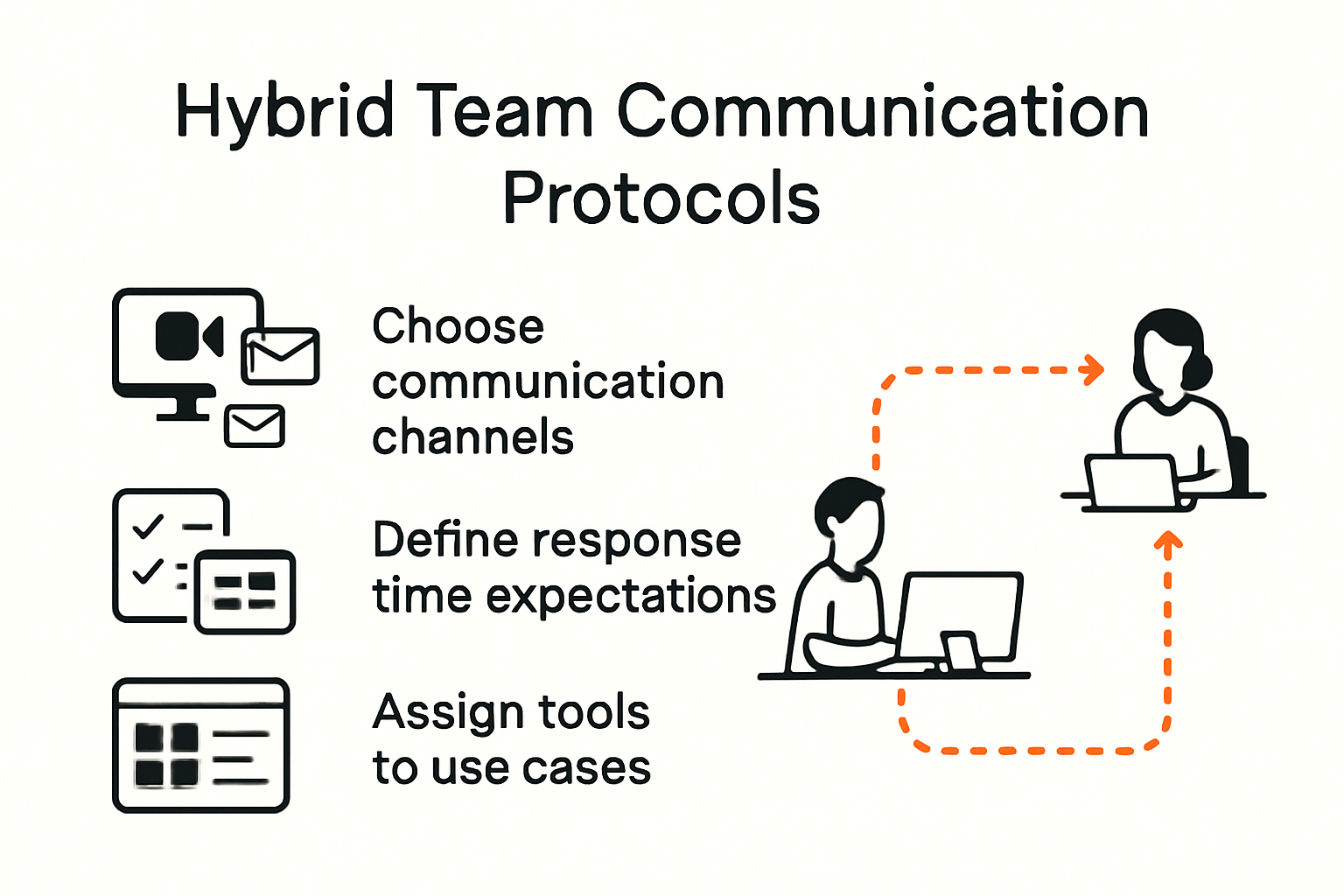Hybrid work is reshaping how teams connect and get things done. You might expect remote work to slow things down or water down company culture. Yet many companies have thrived, with 65 percent of employees saying they feel more productive in a hybrid setup. It is not just about blending home and office life anymore. The real secret is how some organizations turn scattered teams into stronger, more united groups than ever before.
Table of Contents
- Building A Strong Hybrid Work Culture
- Effective Communication In Hybrid Teams
- Ensuring Collaboration And Accountability
- Technology Tools For Hybrid Workplaces
Quick Summary
| Takeaway | Explanation |
|---|---|
| Establish clear communication channels | Use diverse communication tools to bridge physical distances and ensure everyone feels connected. |
| Foster meaningful team interactions | Organize social events and team-building activities to strengthen personal connections among remote and in-office employees. |
| Ensure equitable career opportunities | Guarantee that all employees, irrespective of their work location, have equal access to networking, recognition, and growth opportunities. |
| Implement robust documentation practices | Maintain a centralized digital repository for all project information to ensure transparency and consistency across hybrid teams. |
| Prioritize cybersecurity measures | Adopt strong security protocols to protect sensitive information accessed from various locations to enhance employee flexibility. |
Building a Strong Hybrid Work Culture
Creating a robust hybrid work culture requires strategic thinking and intentional effort from leadership. Organizations must move beyond simply allowing remote and in-office work to actively designing an environment that promotes connection, collaboration, and employee engagement across different work settings.
Establishing Clear Communication Frameworks
Successful hybrid work cultures depend on transparent and consistent communication strategies. Learn more about collaborative communication approaches that bridge physical distances and ensure team alignment. According to Harvard Business Review, organizations must prioritize flexibility and inclusivity in their communication protocols.
Leaders need to implement multiple communication channels that accommodate different work styles and preferences. This might include regular video meetings, asynchronous messaging platforms, shared digital workspaces, and periodic in-person gatherings. The goal is creating an environment where every team member feels equally informed and connected, regardless of their physical location.
Fostering Meaningful Team Connection
Forbes research highlights the critical importance of intentionally building social capital in hybrid work environments. This means creating opportunities for genuine interpersonal interactions that go beyond transactional work discussions.
Organizations can achieve this through structured virtual social events, cross-functional project teams, mentorship programs, and deliberate team-building activities designed to strengthen relationships. These initiatives help combat potential isolation and maintain a sense of collective purpose. Virtual coffee breaks, online game sessions, and periodic in-person meetups can all contribute to maintaining team cohesion.
The following table highlights suggested methods for fostering meaningful team connections in a hybrid environment, summarizing the types and purposes of each activity described in the article.
| Activity Type | Example Initiatives | Purpose |
|---|---|---|
| Social & Team-Building | Virtual coffee breaks, games | Build relationships, reduce isolation |
| Cross-functional Collaboration | Project teams, mentorship | Strengthen ties, support professional growth |
| In-Person Gatherings | Periodic team meetups | Encourage company culture, boost cohesion |
This table provides a quick reference to various strategies organizations can use to maintain strong connections within hybrid teams.
Ensuring Equitable Experiences
A strong hybrid work culture demands fairness and equal opportunities for all employees. This requires careful consideration of how work policies, communication practices, and career development opportunities are designed and implemented. Remote workers should have the same access to professional growth, recognition, and decision-making processes as their in-office counterparts.
Leadership must actively monitor and address potential disparities, using regular feedback mechanisms and performance metrics that evaluate engagement and advancement across different work arrangements. By demonstrating a commitment to inclusivity and fairness, organizations can build trust and motivation among their diverse workforce.
Effective Communication in Hybrid Teams
Hybrid work environments demand sophisticated communication strategies that transcend traditional office interactions. Teams must develop robust communication frameworks that bridge physical distances while maintaining clarity, engagement, and team cohesion.
Establishing Communication Protocols
Explore collaborative decision-making strategies that support effective hybrid team communication. According to Boston University, selecting appropriate communication methods and tools is crucial for hybrid team success.
Teams should define clear expectations about communication channels, response times, and preferred interaction methods. This might include specifying which platforms are used for urgent messages, project updates, informal conversations, and team meetings. For instance, instant messaging for quick questions, video conferencing for complex discussions, and email for formal documentation.

Creating Visibility and Transparency
Carnegie Mellon University emphasizes the importance of making work processes transparent in hybrid environments. This involves implementing project management tools that allow team members to track progress, understand individual contributions, and maintain a sense of collective achievement.
Regular status updates, shared dashboards, and collaborative digital workspaces help eliminate information silos. These platforms enable team members to see project developments in real-time, reducing communication gaps and fostering a sense of shared purpose. Visual representations of work progress can be particularly effective in keeping remote and in-office team members equally informed.
Nurturing Intentional Communication
The University of California, Santa Barbara highlights the critical role of managers in fostering deliberate communication strategies. This goes beyond mere information exchange and focuses on building meaningful connections and maintaining team morale.
Leaders should schedule regular check-ins that are not just task-oriented but also provide space for personal connections. These might include weekly team meetings with dedicated time for informal conversations, virtual coffee breaks, or periodic in-person gatherings. The goal is to create opportunities for spontaneous interactions that typically occur naturally in physical office environments.
By implementing these communication strategies, hybrid teams can overcome geographical barriers, maintain high levels of collaboration, and create a cohesive work environment that supports both individual productivity and collective success.
Ensuring Collaboration and Accountability
In hybrid work environments, collaboration and accountability require strategic approaches that transcend traditional office management techniques. Organizations must design intentional systems that promote transparency, track performance, and maintain team cohesion across different work settings.
Establishing Clear Performance Metrics
Learn about collaborative decision-making strategies that support team accountability. According to the National Institutes of Health research, hybrid teams need structured digital communication strategies and transparent goal-setting mechanisms to maintain productivity.
Performance metrics should focus on outcomes rather than hours worked. This means defining specific, measurable objectives that can be tracked independently of physical location. Key performance indicators (KPIs) should be clearly communicated, regularly reviewed, and tied to both individual and team goals. Digital dashboards and real-time tracking tools can help team members understand their progress and contributions.
Creating Robust Documentation Practices
The U.S. Government Accountability Office emphasizes the importance of comprehensive documentation in hybrid work environments. Detailed documentation ensures that all team members have access to the same information, regardless of their physical location.
Implement a centralized digital repository where project details, decisions, meeting notes, and progress updates are consistently recorded. This approach eliminates information silos and provides a transparent record of work processes. Encourage team members to document their tasks, challenges, and achievements, creating a comprehensive view of team productivity and individual contributions.

Fostering a Culture of Trust and Transparency
Successful collaboration in hybrid teams depends on building a culture of mutual trust and open communication. This requires leadership to model accountability, provide regular feedback, and create safe spaces for honest discussions about work challenges and opportunities.
Regular virtual and in-person check-ins, anonymous feedback mechanisms, and team-building activities can help strengthen interpersonal relationships. Leaders should focus on creating an environment where team members feel comfortable sharing progress, asking for help, and discussing potential obstacles. By prioritizing psychological safety, organizations can develop a collaborative culture that transcends physical work boundaries.
By implementing these strategies, organizations can create a robust framework that ensures collaboration and accountability in hybrid work environments, supporting both individual performance and collective success.
Technology Tools for Hybrid Workplaces
Technology serves as the critical backbone of successful hybrid work environments, enabling seamless communication, collaboration, and productivity across diverse work settings. Organizations must strategically select and implement tools that bridge physical distances while maintaining efficiency and team connectivity.
Communication and Collaboration Platforms
Discover effective task management strategies that leverage modern technological solutions. According to the U.S. Chamber of Commerce, selecting appropriate digital communication tools is fundamental to hybrid workplace success.
Comprehensive communication platforms should offer multiple interaction modes, including instant messaging, video conferencing, and asynchronous communication channels. Tools like Slack, Microsoft Teams, and Zoom provide integrated solutions that support both formal meetings and informal team interactions. These platforms should include features such as screen sharing, real-time collaboration, file sharing, and integration with other workplace productivity applications.
Project Management and Workflow Tools
Effective hybrid workplaces require robust project management technologies that provide transparency and enable team tracking across different locations. Digital platforms like Trello, Asana, and Jira allow teams to visualize project progress, assign tasks, set deadlines, and monitor individual and collective contributions.
These tools should offer customizable dashboards, real-time updates, and comprehensive reporting features. They enable managers to track productivity, identify potential bottlenecks, and ensure that team members remain aligned with organizational objectives. Advanced project management tools can integrate with communication platforms, creating a unified workspace that minimizes information silos and enhances overall team coordination.
Security and Access Management
TechTarget emphasizes the critical importance of robust cybersecurity measures in hybrid work environments. With employees accessing company resources from diverse locations and devices, implementing comprehensive security protocols becomes paramount.
Key security technologies include multi-factor authentication, virtual private networks (VPNs), endpoint protection software, and cloud-based access management systems. Organizations should prioritize solutions that provide secure, controlled access to sensitive information while maintaining employee flexibility. This involves implementing zero-trust security models, encrypting data transmissions, and establishing clear protocols for device usage and information sharing.
By thoughtfully integrating these technological tools, organizations can create a dynamic, secure, and efficient hybrid workplace that supports employee productivity, collaboration, and innovation across multiple work environments.
To help you compare the key features and uses of different technology tools mentioned, the following table summarizes the main platforms discussed in the Technology Tools for Hybrid Workplaces section.
| Tool Type | Example Platforms | Key Features |
|---|---|---|
| Communication & Collaboration | Slack, MS Teams, Zoom | Instant messaging, video meetings, file sharing, real-time chat |
| Project Management & Workflow | Trello, Asana, Jira | Task assignment, visual boards, progress tracking, dashboards |
| Security & Access Management | VPNs, MFA, Zero Trust | Secure login, encrypted data, device & access management |
This comparison makes it easier to select the right tools for supporting hybrid teams based on your organization’s needs.
Frequently Asked Questions
What are some best practices for fostering communication in hybrid workplaces?
Establish multiple communication channels such as video meetings, instant messaging platforms, and regular in-person gatherings to ensure all team members feel connected and informed.
How can organizations create equitable experiences for remote and in-office employees?
Organizations should implement fair career development policies, monitoring disparities through regular feedback and performance metrics, ensuring all employees have access to opportunities, recognition, and decision-making processes.
What technology tools are essential for successful hybrid teamwork?
Key tools include comprehensive communication platforms like Slack or Microsoft Teams for collaboration, project management tools like Trello or Asana for tracking work, and robust security measures such as VPNs and multi-factor authentication to safeguard data.
How can hybrid teams maintain productivity and accountability?
Establish clear performance metrics focused on outcomes, implement robust documentation practices, and nurture a culture of trust and transparency to keep team members aligned and engaged.
Ready to Make Hybrid Teams Work Effortlessly?
Hybrid workplaces bring big opportunities but also new challenges. As highlighted in this article, keeping teams aligned, ensuring transparent communication, and balancing fairness between remote and in-office roles is no small feat. Many leaders struggle with scattered documentation, disconnected workflows, or time-consuming admin work. If you find it tough to keep every team member truly connected and productive, you are not alone.

Transform your team collaboration with Gammatica.com. Our AI-driven platform streamlines your project management, automates repetitive tasks, and gives you instant visibility into goals, milestones, and team engagement. Enjoy features like unified task boards, customizable checklists, and powerful integrations with tools like Zoom and Google Meet. Say goodbye to unnecessary delays and wasted hours. Take the next step—visit Gammatica.com today and discover how you can boost productivity, foster genuine connection, and create a culture of accountability in your hybrid workplace. Your stronger, more efficient team is just a click away.
Recommended
- Collaborative Decision Making for Leaders: Strategies for 2025 | Gammatica
- How to Manage Tasks Effectively in 2025: Proven Strategies for Leaders | Gammatica
- Project Progress Tracking: Strategies for Success in 2025 | Gammatica
- Automation for Small Businesses: Essential Strategies for 2025 | Gammatica



